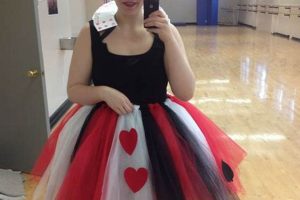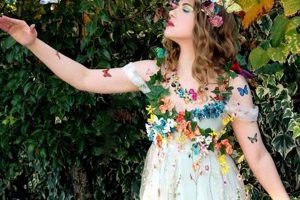The construction of a self-made Princess Peach-inspired outfit represents an avenue for creative expression, particularly for individuals interested in cosplay or themed events. Such endeavors involve the adaptation of readily available materials and crafting techniques to replicate the character’s iconic aesthetic. For example, a pink dress, often modified or sewn from scratch, serves as the base, complemented by accessories like a crown, gloves, and embellishments that capture the princess’s signature look.
Undertaking the creation of such a costume offers several advantages. It allows for significant cost savings compared to purchasing pre-made alternatives. Moreover, the process fosters artistic skills, problem-solving abilities, and a deeper connection to the character being portrayed. Historically, the act of crafting costumes has been a significant part of fandom culture, demonstrating dedication and personal interpretation of established characters.
The following sections will delve into specific techniques for creating the core components, including dress construction, crown fabrication, and accessory design, ensuring a comprehensive guide to realizing an authentic and personalized representation.
Crafting a Princess Peach-Inspired Ensemble
The successful execution of a self-made Princess Peach-inspired outfit requires careful planning and attention to detail. The following tips are designed to guide the creation process, ensuring a polished and recognizable result.
Tip 1: Fabric Selection is Paramount: Opt for materials that mimic the character’s visual aesthetic while prioritizing comfort. Satin or silk blends can provide the necessary sheen for the dress, while ensuring a smooth drape. Prioritize breathability for prolonged wear.
Tip 2: Crown Construction Demands Precision: Accurate representation of the crown is crucial. Use sturdy materials like craft foam or thermoplastic to create the base. Gold paint or metallic adhesive film will achieve the desired luster. Consider a lightweight structure to prevent discomfort.
Tip 3: Pay Attention to Accessory Details: The gloves and brooch are integral elements of the character’s design. Select or craft gloves in the appropriate color and length. The brooch can be replicated using resin, polymer clay, or repurposed jewelry, ensuring accurate color and shape.
Tip 4: Dress Pattern Modification is Key: A commercial dress pattern can serve as a foundation, but modifications are generally required. Adjust the neckline, sleeves, and skirt length to match the character’s specific silhouette. Consider adding petticoats for added volume.
Tip 5: Color Accuracy Enhances Authenticity: Meticulous attention to color matching is essential. Utilize color swatches to select fabrics and paints that closely resemble the character’s established palette. Deviations in color can detract from the overall impact.
Tip 6: Embellishments Elevate the Design: Incorporate subtle details such as ruffles, trim, or appliques to enhance the visual appeal. These embellishments should be thoughtfully placed to avoid overwhelming the overall design.
Tip 7: Utilize Reference Images Consistently: Throughout the creation process, refer to official character artwork to ensure accuracy. These images serve as a valuable guide for proportions, details, and overall design consistency.
The successful creation of a compelling outfit hinges on meticulous planning, careful material selection, and attention to detail. By adhering to these guidelines, individuals can achieve a visually accurate and personally rewarding outcome.
The subsequent sections will address common challenges encountered during the creation process and provide solutions for overcoming these obstacles.
1. Dress Silhouette
The dress silhouette is paramount in the successful creation of a Princess Peach DIY costume. Its accurate representation is essential for immediate character recognition and overall aesthetic impact. Variations from the established form can detract from the costume’s authenticity.
- Foundation Garment Influence
The underlying structure of the dress, achieved through the choice of foundation garments such as petticoats or crinolines, significantly impacts the silhouette. These elements contribute to the volume and shape of the skirt, which is characteristic of Princess Peach’s design. Insufficient support will result in a less defined and inaccurate appearance.
- Bodice Construction and Proportions
The bodice’s construction dictates the upper portion of the dress’s shape. Careful attention to seam placement, dart manipulation, and the addition of boning (if necessary) ensures a smooth and fitted appearance. The proportions of the bodice, in relation to the skirt, are critical for replicating the correct silhouette. An improperly sized or shaped bodice will distort the overall aesthetic.
- Skirt Style and Volume
The skirt’s style, typically a full or A-line shape, contributes significantly to the overall impression. The amount of fabric used, the presence of pleats or gathers, and the incorporation of layers all affect the skirt’s volume and drape. Accurately capturing these elements is crucial for achieving the desired Princess Peach silhouette. A skirt that is too flat or excessively voluminous will deviate from the established design.
- Neckline and Sleeve Considerations
While the overall silhouette is dominated by the bodice and skirt, the neckline and sleeves also play a role. The choice of a specific neckline, such as a scoop or sweetheart, influences the perceived shape of the upper body. Similarly, the sleeves’ style and length contribute to the overall design. These details, although seemingly minor, contribute to the fidelity of the costume.
The interplay of these factors determines the success of the dress silhouette within the context of creating a Princess Peach DIY costume. Accuracy in each aspect directly correlates to the recognizability and visual impact of the finished product, exemplifying the importance of meticulous planning and execution. Deviation in any one component can detract from the overall authenticity.
2. Crown Replication
Successful replication of the crown constitutes a critical element in the creation of a Princess Peach DIY costume. The crown serves as an instantly recognizable symbol of the character, and its accurate representation significantly impacts the costume’s overall effectiveness. Failure to adequately replicate the crown can diminish the visual impact, rendering the costume less authentic and recognizable. For instance, a poorly shaped or colored crown will detract from the overall design, even if other components are well-executed.
The process of crown r
eplication necessitates the careful selection of materials and techniques. Craft foam, thermoplastic, and repurposed materials are commonly employed. The chosen material must be amenable to shaping and retain its form. Furthermore, the application of appropriate paints, metallic finishes, or decorative elements is essential to accurately reflect the crown’s visual characteristics. The scale and proportions of the crown relative to the wearer’s head must also be carefully considered to maintain visual harmony. Examples of successful crown replication include the use of 3D-printed models refined with hand-painting or the skillful manipulation of craft foam to mimic the crown’s intricate details.
In summary, accurate crown replication is not merely an aesthetic consideration but a fundamental requirement for a successful Princess Peach DIY costume. Challenges in crown construction, such as achieving structural integrity or accurate color matching, must be addressed to ensure a visually compelling and recognizable representation of the character. The effort dedicated to achieving accurate crown replication directly correlates with the overall success and impact of the costume.
3. Fabric Acquisition
The selection and procurement of appropriate fabrics, or “Fabric Acquisition”, represents a foundational step in the creation of a Princess Peach DIY costume. The type, color, and texture of the chosen materials directly impact the costume’s visual fidelity and overall quality. Incorrect fabric selection can lead to a costume that deviates significantly from the character’s established aesthetic. For example, using a coarse, matte fabric instead of a smooth, shimmering one will fail to capture the elegance associated with the character’s dress. The selection of a fabric with poor draping qualities can result in an unflattering silhouette. Therefore, the process of fabric acquisition is not merely about obtaining material but about making informed decisions that align with the desired outcome.
The practical significance of informed fabric acquisition extends beyond mere aesthetics. Fabric weight and breathability influence the wearer’s comfort, particularly during extended wear. For example, a heavy, non-breathable fabric can cause discomfort and overheating, detracting from the overall experience. Furthermore, fabric durability determines the costume’s longevity. Investing in higher-quality fabrics, while potentially more expensive, can result in a costume that withstands repeated use and cleaning. The decision between synthetic and natural fibers also plays a role; synthetic fabrics may offer greater stain resistance, while natural fibers may provide superior comfort. The accessibility of fabrics within a given budget constrains options. The ability to identify cost-effective alternatives that maintain the desired visual effect is a critical skill in costume construction. Sourcing fabric remnants, utilizing sales, or exploring online marketplaces can optimize resource allocation without sacrificing quality.
In summary, fabric acquisition for a Princess Peach DIY costume is a multifaceted process that demands careful consideration of aesthetic, practical, and budgetary constraints. The consequences of poor fabric selection extend beyond visual inaccuracies to encompass comfort, durability, and overall cost-effectiveness. Success in fabric acquisition enhances the fidelity and longevity of the finished costume, thereby contributing to a more compelling and satisfying outcome.
4. Accessory Crafting
Accessory crafting represents an indispensable component within the creation of a self-made Princess Peach costume. These crafted elements, ranging from the character’s iconic brooch to her gloves and earrings, directly influence the costume’s recognizability and overall visual impact. The degree to which these accessories accurately reflect the character’s established design directly correlates to the success of the entire endeavor. Inaccurate or poorly executed accessories can diminish the effectiveness of even a well-constructed dress, underscoring the importance of meticulous accessory crafting.
Consider, for example, the crafting of Princess Peach’s brooch. Its distinct shape and color are essential identifiers. A brooch that deviates significantly from the established design either in form or coloration creates a jarring visual dissonance. Similarly, the gloves, typically long and white, contribute significantly to the character’s regal bearing. The length, material, and even the subtle sheen of the gloves contribute to the overall effect. Crafting these elements requires attention to detail, appropriate material selection, and, in some instances, the application of specialized techniques, such as working with delicate fabrics or creating custom molds for jewelry components. Furthermore, the accessories’ scale and proportion relative to the wearer are vital considerations. An oversized or undersized accessory can appear incongruous, disrupting the overall harmony of the costume.
In conclusion, accessory crafting for a Princess Peach DIY costume is not merely an ancillary activity, but an integral part of the overall design process. The accuracy, quality, and proportionality of the accessories contribute directly to the costume’s success. While challenges such as replicating intricate details or sourcing appropriate materials may arise, the effort invested in meticulous accessory crafting significantly enhances the visual impact and overall recognizability of the self-made Princess Peach costume.
5. Color Palette
The color palette holds substantial importance when constructing a Princess Peach DIY costume. The character’s visual identity is intrinsically linked to a specific set of colors, predominantly varying shades of pink for her dress, along with complementary hues such as gold for her crown and white for her gloves. Deviations from this established palette significantly impact the recognizability and overall effectiveness of the costume. The selection of materials and the application of dyes or paints necessitate a precise understanding and adherence to the intended color scheme. Using incorrect shades can lead to a visual disconnect, rendering the costume less authentic and immediately identifiable.
Achieving accurate color representation presents several practical challenges. Fabric dyes can vary in shade based on material composition and lighting conditions. Therefore, careful testing and comparison against reference images are essential. Utilizing color swatches during fabric selection and paint mixing assists in maintaining consistency. Furthermore, understanding color theory informs the choice of complementary and accent colors. The correct shade of pink for the dress, for instance, may necessitate careful mixing of dyes or the selection of a pre-dyed fabric that closely matches the desired hue. Examples of effective color palette implementation include costumes where the fabric has been custom-dyed to achieve an exact match or where metallic paints have been skillfully applied to replicate the luster of the crown. Conversely, examples of ineffective color palette use often involve costumes where the pink is too saturated, too pale, or leans towards a different hue altogether, such as magenta or cor
al. The consequence is a diminished resemblance to the character.
In summary, the color palette is not merely an aesthetic consideration but a fundamental element in the successful creation of a Princess Peach DIY costume. Accurate color matching, informed by both artistic understanding and practical experimentation, directly impacts the costume’s authenticity and visual appeal. Attention to detail in this regard ensures that the finished product effectively captures the character’s iconic look. The challenges associated with color matching underscore the importance of careful planning and execution during the construction process.
6. Construction Skill
Construction skill represents a fundamental determinant in the feasibility and ultimate success of creating a self-made Princess Peach costume. The degree of proficiency in various crafting and sewing techniques directly influences the complexity, accuracy, and overall quality of the finished product. Inadequate construction skill can lead to a costume that deviates significantly from the intended design, lacks structural integrity, or exhibits a substandard aesthetic appearance. The following outlines the key facets where construction skill plays a critical role.
- Pattern Modification and Garment Assembly
The ability to modify existing commercial patterns or draft custom patterns is essential for achieving the specific silhouette and details of Princess Peach’s dress. Skilled garment assembly involves precise sewing techniques, including dart manipulation, seam finishing, and the proper installation of zippers or closures. Inadequate skill in this area may result in a poorly fitting garment with uneven seams or structural weaknesses. An example is the alteration of a basic A-line dress pattern to incorporate the character’s signature high-waisted bodice and voluminous skirt.
- Fabric Manipulation and Embellishment Techniques
Effective fabric manipulation encompasses techniques such as gathering, pleating, and draping, which are crucial for creating the desired fullness and texture in the dress’s skirt and sleeves. Embellishment techniques, including appliqu, embroidery, and the application of trims, add visual interest and enhance the costume’s authenticity. Lack of proficiency in these areas may result in a flat, lifeless garment lacking the characteristic details of the Princess Peach design. An example is the skillful application of delicate lace trim to the bodice neckline or the creation of hand-embroidered details on the skirt.
- Crown and Accessory Fabrication
Constructing the crown and other accessories, such as the brooch and earrings, requires skills in crafting and sculpting. This may involve working with materials such as craft foam, thermoplastic, or resin. Accurate shaping, surface finishing, and the application of metallic paints or finishes are essential for replicating the intricate details of these elements. Deficiencies in these skills can lead to accessories that appear amateurish or fail to capture the character’s iconic design. An example is the use of thermoplastic to mold a lightweight, durable crown that is then finished with metallic gold paint and embedded with faux gemstones.
- Problem-Solving and Adaptation
Costume construction often involves unexpected challenges, such as fabric shortages, pattern discrepancies, or the need to adapt techniques to accommodate unconventional materials. Skilled costume makers possess the ability to troubleshoot problems effectively and devise creative solutions to overcome these obstacles. This adaptability is crucial for completing the project successfully and achieving the desired outcome. An example is improvising a solution to create the voluminous skirt when the desired fabric is unavailable by using multiple layers of a less expensive material.
These facets highlight the integral relationship between construction skill and the successful execution of a self-made Princess Peach costume. The level of proficiency in these areas directly impacts the authenticity, durability, and overall aesthetic quality of the finished product, underscoring the importance of acquiring and honing these skills for aspiring costume creators.
7. Budget Allocation
Budget allocation is a critical factor governing the feasibility and ultimate appearance of a self-made Princess Peach costume. Resource limitations necessitate strategic decisions regarding material selection, construction techniques, and the scope of embellishments. Inadequate allocation can compromise the costume’s visual fidelity and structural integrity.
- Fabric Tier Selection
Budgetary constraints often dictate the grade of fabric employed. High-end silks or satins, known for their luxurious drape and sheen, represent a significant investment. More economical alternatives, such as polyester blends, offer a cost-effective solution but may lack the visual depth and tactile qualities of premium fabrics. The selection process involves balancing aesthetic aspirations with budgetary realities, potentially requiring compromises on material quality to remain within defined financial parameters. For example, opting for a matte polyester instead of a shimmering silk reduces costs but alters the overall visual effect.
- Accessory Material Choices
The replication of accessories, including the crown, brooch, and earrings, presents budgetary considerations. Authentic gemstone settings and precious metal finishes incur substantial expenses. Cost-effective alternatives include crafting accessories from materials such as craft foam, resin, or repurposed jewelry components. Applying metallic paints or adhesive films can simulate the appearance of precious metals at a fraction of the cost. The selection of accessory materials directly impacts the level of detail and realism achievable within the confines of the allocated budget. For instance, utilizing craft foam for the crown’s base allows for intricate shaping at a lower cost than employing a 3D-printed model.
- Construction Technique Simplification
Complex construction techniques, such as intricate pleating, hand embroidery, or the incorporation of boning for structural support, demand both time and specialized skills. Budgetary restrictions may necessitate simplifying these techniques to reduce labor costs or minimize the consumption of expensive materials. Streamlining the construction process, while preserving the costume’s essential characteristics, requires careful planning and creative problem-solving. For instance, substituting hand-stitched embellishments with machine-applied appliques lowers construction time and cost without sacrificing visual appeal entirely.
- Embellishment Scope Limitation
The extent and complexity of embellishments, such as the addition of lace trim, sequins, or faux gemstones, directly impact the overall cost of the costume. Limiting the scope of embellishments or opting for less expensive alternatives can significantly reduce expenses. The decision-making process involves prioritizing the most visually impactful embellishments while streamlining or omitting less essential details. For example, concentrating embellishments around the bodice and neckline, while minimizing them on the skirt, creates a focal point without exceeding budgetary constraints.
The allocation of financial resources directly shapes the final form and quality of a Princess Peach costume. Strategic budgeting decisions, informed by a clear understanding of material costs, construction techniques, and embellishment options, determine the level of fidelity and visual impact achievable within the specified financial constraints. Effective budget allocation enables the creation of a recognizable and aesthetically pleasing costume, even when operating under limited financial resources.
Frequently Asked Questions
The following addresses common inquiries and misconceptions regarding the creation of a self-made Princess Peach costume. The intention is to provide clarity and guidance for those undertaking this project.
Question 1: What constitutes the most challenging aspect of creating a Princess Peach DIY costume?
The accurate replication of the crown often presents the greatest challenge. Achieving the correct shape, proportions, and metallic finish requires specialized skills and materials.
Question 2: Is it possible to create a high-quality Princess Peach DIY costume on a limited budget?
Yes, strategic material selection and simplified construction techniques can yield a visually appealing costume within budgetary constraints. Focus on core elements and prioritize cost-effective alternatives.
Question 3: What fabrics are most suitable for replicating Princess Peach’s dress?
Satin or silk blends offer the desired sheen and drape. Polyester alternatives can provide a more budget-friendly option, although they may lack the luxurious feel of natural fibers.
Question 4: How important is it to accurately match the character’s color palette?
Precise color matching is essential for recognizability. Utilize color swatches and reference images to ensure the fabric and embellishments closely align with the character’s established colors.
Question 5: What level of sewing skill is required to create a Princess Peach DIY costume?
A basic understanding of sewing techniques is necessary. However, more complex designs may necessitate advanced skills in pattern modification and garment construction.
Question 6: Can accessories be purchased instead of crafted?
Pre-made accessories are available but may not precisely match the desired aesthetic. Crafting accessories allows for greater customization and control over the final appearance.
Accurate replication of key elements, strategic resource allocation, and a basic understanding of sewing principles are paramount. Addressing these considerations enhances the likelihood of a successful outcome.
The next section will address common pitfalls encountered during construction and offer potential solutions.
Conclusion
The preceding analysis has explored the multifaceted nature of the Princess Peach DIY costume endeavor. From fabric acquisition to crown replication and budget allocation, success hinges upon meticulous planning and the skillful execution of various crafting techniques. An accurate representation necessitates a deep understanding of the character’s established visual identity and a commitment to faithfully recreating each component. The challenges inherent in this undertaking underscore the importance of preparation and resourcefulness.
The construction of such a costume represents more than a mere crafting project; it embodies a commitment to detail and a dedication to realizing a specific artistic vision. Further exploration of advanced techniques and innovative material utilization will undoubtedly refine the process and elevate the quality of subsequent Princess Peach DIY costume creations. Continued focus on accuracy and ingenuity remains paramount for future iterations.





![DIY Hippo Costume: Make Your Own! [Easy Guide] The DIY Hub: Creative Crafts, Repairs & Life Hacks DIY Hippo Costume: Make Your Own! [Easy Guide] | The DIY Hub: Creative Crafts, Repairs & Life Hacks](https://craftingdiycenter.com/wp-content/uploads/2025/07/th-7233-300x200.jpg)

